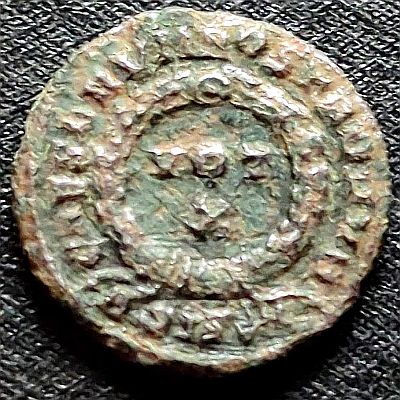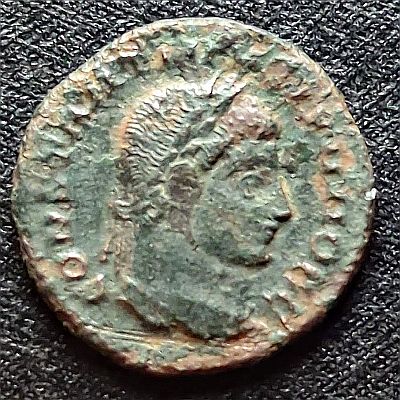An early commemorative coin

When I think of commemorative coins, I tend to think of modern designs, made as much to sell collector items as anything else. The pieces issued on the 70th jubilee, then passing of the late Queen Elizabeth, and at crowning of Charles III all come to mind. These things should be commemorated of course, and as a collector, I have to say, there was “something for everyone, and every budget” between those themes.
But recognising milestones with commemorative coins is not a new phenomenon. There are many ancient coins commemorating noteworthy events. There were numerous designs issued to mark the founding of Constantinopolis, for instance.
The inscription around this coin reads: “Caesarvm Nostrorvm” with “VOT X” in the centre. Unabridged, this means: “Caesarum Nostrorum Votis Decennalibus”, which translates to: “Vows for the tenth anniversary of reign of our caesars.”
This is quite different to modern commemoratives. This coin is vowing to serve, and looking forward to, the tenth anniversary of reign for the caesars. Thank you so much to Greenseer for getting me on the right track here – I spent awhile trying to work out what ten year anniversary had recently occurred in 321.
This coin has ASIS at the bottom of the wreath. SIS is the mint, Siscia, which is modern-day Sisak, Croatia. And the “A” at the start, indicates the “First officina”. The Officina was the workshop within the mint which created the coin. At western mints the marks P, S, T, and Q indicated the prima (1st), secunda (2nd), tertia (3rd), and quarta (4th) officina. At eastern mints Greek numerals were used to indicate the officina from A (1st) to IE (15th).

The obverse of the coin depicts Constantine II, reading: “Constantinus Iunior Nobilissimus Caesar”, which translates to: “Translation: “Constantine the Younger, most noble caesar”. Let’s step back for a moment to cover the Tetrarchy.
In the third century (200 – 300 A.D.) there were no less than twenty-four emperors exchanged at the throne and at least sixty men tried to claim it. This instability wasted resources and killed many in an often vicious circle. To resolve this, Emperor Diocletian appointed Maximian as co-emperor, with each ruling over half. This was highly unusual, as Maximian was not Diocletian’s relative but was chosen based on merit. Because the two men continued to be challenged by usurpers, Diocletian established the Tetrarchy – the “rule of four.” By appointing two more junior emperors (Caesares), again based on merit, Diocletian hoped to avoid further usurpation. Thus, the death of one of the Tetrarchs would not lead to the destabilization of the government, and the Empire’s unity was kept intact.
When this coin was issued, sometime between 321 – 324 A.D., Constantine II was actually only five – eight years old. So the message is as much praying for stability and longevity of rule, as it is commemorating a group of rulers who believed they could achieve it.
So there is an early commemorative coin. What is the earliest commemorative coin you know of? Do share your thoughts in the comments below!


Leave a Reply